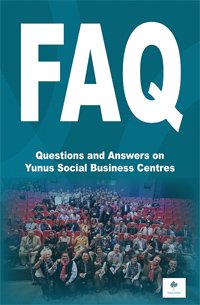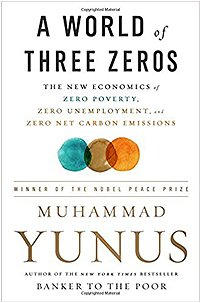Q&A ‘Wherever I See a Problem, I Create a Business to Solve It’
Muhammad Yunus, the Nobel Prize-winning economist, wants to transform U.S. foreign aid.
By Sara Sorcher and Catherine Hollander
Published on: May 9, 2013
A loan, not a handout: Yunus (Chet Susslin)
Economist Muhammad Yunus introduced the world to the concept of microfinance, or small-scale loans with low interest rates and a long repayment timeline, through his Grameen Bank in his native Bangladesh. Yunus and just six others—Martin Luther King Jr., Nelson Mandela, and Mother Teresa among them—have received the Nobel Peace Prize, the U.S. Presidential Medal of Freedom, and the Congressional Gold Medal, which Yunus was awarded in a Capitol Hill ceremony this month. Edited excerpts of his conversation with NationalJournal follow.
NJ What was your first microloan, and when did you realize microfinance was a viable concept?
YUNUS Back in 1976, in one village next to the university where I was teaching, was awful poverty and famine. I didn’t know what I [could] do. I saw how terrible the loan-sharking was. I thought, “Well, I can solve this problem; all I have to do [is] lend the money myself.” I was not worrying whether they were going to pay me back. Then, as it became popular, I thought, “I should link the bank with them, instead of me always coming up with my money.” And the bank said, “No, it cannot be done.” Ultimately, I came up with the idea, “Why don’t I offer myself as a guarantor and make sure the bank doesn’t lose money?” The first loan I gave was $27 [distributed among] 42 people. I had to come up with the idea of how to get the money back, otherwise the bank will not. So I started coming up with the rules, procedures, which will make it easy for them to pay back. And that’s how I came to the idea of paying back [in a] weekly installment. If you take a $100 loan—which is way big, just for the example I’m giving—every week you pay $2. That has become kind of a signature mark of microcredit.
NJ Now the United States has 15,000 microborrowers. How did this get started?
YUNUS I was invited to come to Arkansas in 1986 by Governor [Bill] Clinton. He came to know about our work in Bangladesh. He thought this would be useful for him to do a similar thing in Arkansas, because Arkansas is one of the poorest states in the country. Then it spread in other places, in Chicago and among the Navajo Indians and Cherokee Indians and so on. In his first presidential campaign, [Clinton] took this item as one of his campaign pledges, that “if I’m elected president, I’ll have Grameen programs started in all inner cities of the United States.” Journalists kept asking, “What is this Grameen program?” He says, “Oh, it’s in Bangladesh.” [They said], “You mean you want to bring something from Bangladesh?” He was ridiculed.
In 2008, we started this program in New York City. We have given out more than $35 million. The average loan [is] $1,500 and the repayment rate is 99.4 percent. It is spreading in other cities like Omaha, Nebraska, in Indianapolis, in Los Angeles, in San Francisco, in Charlotte, North Carolina. We are hoping that gradually, the numbers of borrowers in a few years’ time will exceed 50,000 [in the United States].
NJ What are the microloans used for here in the U.S.?
YUNUS Women do what they are familiar with, like hairdressing. Either they have training or they have worked as a hairdresser but lost the job. Now, with this money, she rents a chair in the hairdressing salon, and she is an independent businesswoman. Pet care is again a very popular thing. Catering services. Day care. House-cleaning service.
NJ What’s “social business”?
YUNUS Whenever I see a problem, I create a business to solve it. In a charity, which is a very good thing, money goes out. It doesn’t come back. If you can transform [fixing the problem] into some kind of business model, then money goes out [and] it comes back. So you can do the same thing over and over again with the same money.
NJ Foreign aid is usually unpopular, especially during tight financial times. Is there a way to incorporate microfinance and social-business concepts to change the face of U.S. foreign-aid platforms?
YUNUS When you create a business, it cannot disappear. When it’s a charity, you give—it’s done, and that’s the end of it. But if you’re a business, five years later you go back, it’s still running, still doing the job, maybe doing better than the first year. It has a life; in a charity, you don’t create a life. You also create dependence. If you don’t repeat the same thing next year, it won’t be done. To give one concrete example: Roads are built with donor money. Beautiful roads. But there’s no maintenance money included. You go back five years later and that road is not the same road that you built—it’s this sort of potholes, falling apart, because nobody’s maintaining it. I’m not against giving grants. I’m saying there are certain areas where you can create businesses. You are encouraging people—local people—to come up with their solutions in a business way.
NJ Are American policymakers receptive?
YUNUS They like the idea. But they cannot move out of [the current model of foreign aid]. Who will take the decision of how to do something else? So I’ll keep on encouraging. I’ll show the [Congressional] Gold Medal [and say,] “See, you gave it to me!” So now it’s legitimate. That gives them courage.
This article appears in the May 11, 2013, edition of National Journal as A Micro-Revolution.
Source: National Journal


